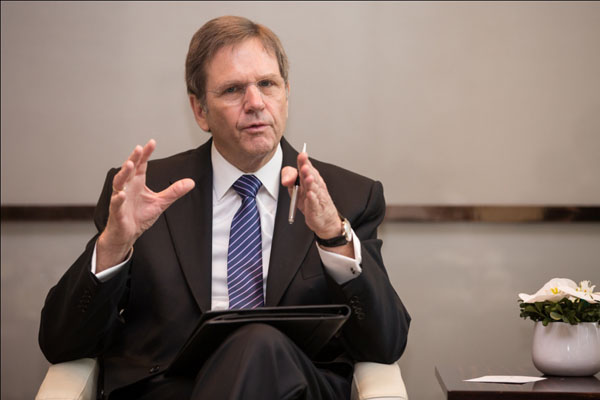2014 Auto China
Beijing Conrad Hotel
Jochem Heizmann: member of the board, Volkswagen Group, and president and CEO, Volkswagen China
 |
| Jochem Heizmann [Photo provided to chinadaily.com.cn] |
Heizmann: I’m happy to have the opportunity to talk with you. On Volkswagen Group Night, we said electric-mobility is a very important global strategy for Volkswagen, but I think it’s probably more important in China. We’ve rolled out Panamera S E-Hybrid here and will introduce electric-up!, and the e-Golf, Golf GTE, and Audi A3 e-tron plug-in hybrid models to China in future. And, we’ll produce electric vehicles locally in China from 2016, including Audi A6 and a new C-class sedan, and give special attention to developing plug-in hybrid power models. That Group night, we celebrated the Group’s having delivered 20 million cars to Chinese customers. And, we’re full of confidence in this year’s performance. The Volkswagen Group is expected to deliver 3.5 million cars in China this year and aims to have two-digit growth in sales.
We need to expand our dealer network to reach this goal so there will be 350 new shops opening this year, bringing the total number to 2,750. The Volkswagen Group and its joint ventures have approximately 80,000 employees and the number of employees at our dealers has reached 360,000. The total number of employees in the Group, joint ventures and at dealers will grow to 600,000 by 2018, meaning more quality employment opportunities.
Q: You said that e-vehicles will be locally produced in China by 2016, and what does ‘locally produced’ mean?
Heizmann: When the Volkswagen Group starts producing e-vehicles in China they will be the Audi A6 hybrid power model, jointly developed with the FAW-Volkswagen Group, and a C-class sedan from Volkswagen Group and Shanghai Volkswagen. The two models are both plug-in hybrid power and have two power modes, the first of which is pure electric power and can go 50 kilometers, enough for city driving. If customers want to explore farther, say, going out on weekends, the internal combustion engine will kick in.
The Volkswagen Group a different strategy from other car companies, in e–vehicle R&D. For example, we use modular platforms that consist of MLB and MQB and we have already started developing these platforms for e-vehicles. The one for e-vehicles is more finely tuned than the one for internal combustion engine cars. This means we can continue to use existing equipment and production lines to produce both internal combustion engine cars and plug-in hybrids.
Q: Some of your rivals have been developing hybrid power cars in China for seven or eight years but with few positive results. I’d like to know if it’s possible for Volkswagen Group to produce engines and batteries in China.
Heizmann: I think our competitors have focused on developing micro-hybrids, which are completely different from Volkswagen’s plug-in hybrid power model. They also have nothing in common when it comes to duration or mileage. And their battery recovery and charging are different. Our core parts, including battery system, will be developed and produced in China in future. The e-mobility project can meet customer demand and have mass production because we can produce both traditional internal combustion cars and plug-in hybrid models thanks to our flexible production system. First we’ll focus on MLB to produce e-vehicles, and then on MQB to produce plug-in hybrid models.
